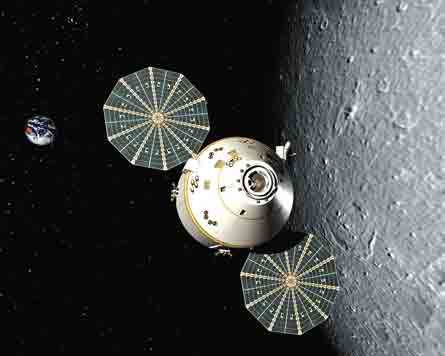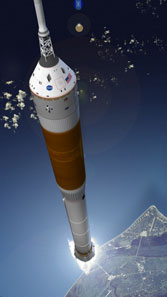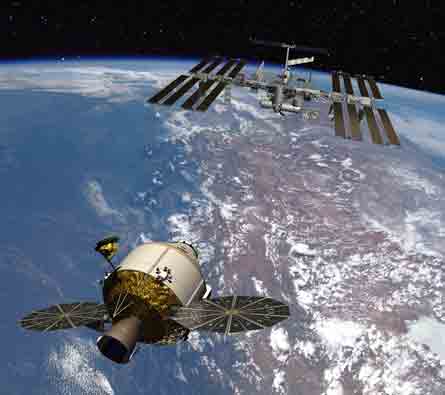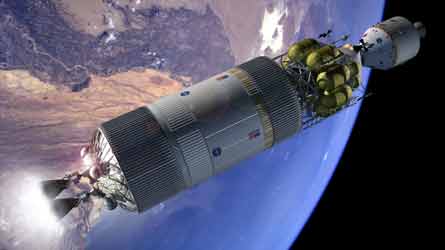It has been 34 years since the last manned spacecraft landed on the Moon. Now it is Lockheed Martin's job to deliver the vehicle for the return in 2018
The four astronauts float through the tunnel connecting the Orion crew module and the Lunar Surface Access Module (LSAM). It is 6 April 2018 and the four US explorers are hours from landing on the Moon, the first such visit by human beings in 46 years.
As they undock the LSAM from the Orion spacecraft that has taken them to the Moon, they look back through the windows at their return vehicle that will stay in an autonomous 100km (62 miles) lunar orbit for the few days they are on the surface.
|
|---|
Lockheed's Orion could eventually orbit the Moon for six months at a time |
This vision of the future came one step closer to reality on 31 August when NASA announced the prime contractor to develop and build its four- to six-crew Orion spaceship for its Constellation programme. In the solicitation for the $8.15 billion award, the US space agency stipulated the date for returning to the Moon should be no earlier than 31 March 2018.
The last time NASA invited proposals for a Moonship was in 1961 after President John Kennedy's historic 25 May speech to a joint session of Congress committing the USA to landing on the moon before the end of the decade. Six months later NASA awarded the contract for Kennedy's Apollo programme's manned spacecraft, on 28 November 1961.
The Apollo command and service module work was awarded to North American Aviation, now part of Boeing after its 1967 merger with Rockwell and that company's amalgamation with Boeing in 1997.
Almost 46 years later, NASA is dividing Constellation's Orion contract work, won by Lockheed Martin Space Systems, into three schedules. From 8 September this year to September 2013, Lockheed will undertake the first schedule, the design, development, test and evaluation (DDT&E) of the Orion, worth $3.9 billion.
Credible plans
At the 31 August announcement at NASA headquarters in Washington DC, the US agency's Orion project manager Caris Hatfield said: "We challenged the [teams] in the proposal process to do better than the guidance we gave [for operational dates]. They both came forward with plans that did better." The bidders told Hatfield they could deliver the Orion before the 2014 date NASA had set for the vehicle's start of operations, and NASA deputy associate administrator for exploration Doug Cooke says he is satisfied those plans "are credible" after examination of the industry teams' planning.
"If the budget and requirements stay stable we could deliver Orion in 2012," says Lockheed Martin's Project Orion business development manager Patrick McKenzie, who told Flight International last week that he was still "giddy" from the announcement.
The second schedule covers the post-development production orders for crew and cargo versions, which begin as early as September 2009 - potentially realising the earlier start date that bidders promised. This $3.5 billion phase will continue until 7 September 2019. The third phase is worth $750 million and is for the provision of additional spacecraft and related engineering services from 2009 to 2019.
Lockheed won a selection process that had two phases. McKenzie cites Lockheed's willingness for partnership, tapping into the existing NASA workforce, its technical solutions and team credentials as reasons why it won, but he admits he does not know the precise reasons and is waiting for the final NASA debrief this or next week.
Both Lockheed and its competitor, a Northrop Grumman/Boeing team, were awarded $28 million contracts for phase one covering concept refinement, trade studies, requirements analysis and preliminary vehicle design options.
The phase two DDT&E contract, the request for proposals for which were published in March 2005 and last January, had two submission deadlines in March and April due to last-minute NASA changes, including an Orion outer-mould diameter reduction from 5.5m (18ft) to 5m.
NASA says the reduction was because the internal volume of a 5m-wide module is sufficient for mission needs, although other industry sources suggest it is to reduce weight because of the limitations of Orion's Ares I launcher and the decision to drop the more powerful methane, liquid-oxygen engines for Orion's propulsion.
Today the baseline requirement is a 25,000kg (55,000lb) vehicle with 10.2m3 (360ft3) of habitable volume inside the crew module. Orion will be constructed of aluminium lithium using friction stir welding technology. Its service module will have many composite components. Lockheed will provide the adaptor to connect Orion with Ares I's upper stage.
According to NASA Constellation programme internal planning documents obtained by Flight International, the Orion development timetable calls for the system requirements review (SRR) by the end of this year, the system design review by May 2007, the preliminary design review (PDR) by February or March 2008 and the critical design review for the second quarter of 2009. Deliveries for an unmanned September 2012 Atmospheric Demonstration Flight Test (ADFT) and for the first Orbital Flight Test (OFT) in September 2013 are expected in August and December of 2011, respectively.
However, McKenzie expects SSR to slip to the first quarter of 2007. Over the next two months Lockheed expects to work with NASA to mesh together the development plans for Orion, which could not be done while the competition was ongoing.
Orion variants
The substantial difference in delivery and launch in the leaked timetable is due to NASA planning for almost nine months of what it calls ADFT processing, and waiting up to a year for the Ares I to be delivered before OFT-1 processing begins. NASA held its internal Constellation programme review to approve this process in April. If that is NASA's view then how does Cooke think the bidders could do it quicker?
|
|---|
Orion will be launched on the Ares I from Kennedy Space Center |
Because of Orion's Moon and International Space Station (ISS) missions, the phase 2 solicitation specified three variants. Block 1A is a crewed, pressurised vehicle for low-Earth orbit missions Block 1B is an uninhabited, pressurised vehicle for ISS resupply and Block 2 is a crewed, pressurised vehicle for lunar missions.
NASA expects minimal subsystem changes between Block 1A and 1B, while Block 2 should only see software changes. The agency will provide the crew module's thermal protection, landing and docking systems and propulsion technology, including that of the service module.
Johnson Space Center in Houston will manage Orion and most of the engineering work for the vehicle will be performed there, while NASA Glenn Research Center in Ohio will be responsible for the service module and Marshall Space Flight Center in Alabama will manage Ares I and the LSAM.
McKenzie expects its Exploration Development Center Project Orion headquarters in Houston to be fully staffed, with perhaps up to 1,200 engineering, software development and testing jobs, in 18 months' time. Those personnel will be from Lockheed's consortium members, employees drawn from other parts of Lockheed and personnel new to the space programme. The Lockheed Orion team will have a human spaceflight advisory council that will include Apollo veterans.
The Houston area local government offered job training aid and other incentives for the Orion winner to locate there.
Louisiana is another state to benefit from NASA's Orion decision. Lockheed will manufacture the service module and crew module structures at the NASA Michoud Assembly Facility near New Orleans, which it manages.
Lockheed's consortium includes Orbital Sciences, Hamilton Sunstrand and Honeywell. Hamilton Sunstrand will supply 13 life-support systems, including fire detection and suppression and potable/cooling water storage in a deal it says is worth hundreds of millions of dollars.
For Orion's avionics, Honeywell will supply Boeing 787-derived electronics. The avionics development work will be performed at the company's Phoenix, Florida, Houston and Minnesota sites. The electronics will be radiation hardened and adapted for the thermal, vacuum and launch-related vibration environments. "We wanted to go with something we knew would have had a lot of flight time," says McKenzie, who considers the avionics a critical path item for Orion to meet a 2012 or 2014 first flight date.
NASA teams
For NASA, Maryland-based Goddard Space Flight Center will co-lead the navigation, software and avionics integration along with the Jet Propulsion Laboratory.
This time around, NASA wants to employ automatic docking. Lockheed's team has been interested in exploiting NASA's Demonstration of Autonomous Rendezvous Technology (DART) programme. DART was developed for automated rendezvous, station-keeping, andcollision avoidance in space, using video guidance and laser reflector technology. But it failed in its maiden mission to rendezvous with a disused satellite in April 2005.
NASA is considering two docking mechanisms. In a 9 February phase two solicitation amendment, the Orion's docking system was changed from the Low Impact Docking System (LIDS) to the Space Shuttle's Androgynous Peripheral Assembly System (APAS), which it uses to dock with the ISS. The agency still wants to use LIDS, but for docking Orion with LSAM.
|
|---|
Orion will carry a crew of six to the International Space Station |
NASA's Ames Research Center is developing the thermal protection system (TPS) that NASA plans for both ISS and lunar missions. For the latter, the material will need to withstand a re-entry heat flux of up to 1,000W/cm2.
Heat shield
Lockheed wants to use the Phenolic Impregnated Carbon Ablator developed by NASA Ames and used for Lockheed's cometary-dust capturing Stardust capsule, which returned to Earth in January. McKenzie says: "We have baselined for the TPS the Stardust capsule material."
Ames researchers expect that whichever potential TPS option is selected at the Orion PDR, it will be ablative. In the meantime, the Johnson Space Center wants to have an assured TPS for the Orion's initial ISS missions and has bought Space Shuttle tile material. This new TPS, says NASA, needs to endure a heat flux of up to 200W/cm2, where Shuttle tiles only endure 50W/cm2. But while Space Shuttle's tiles are reused, the Orion's TPS will be disposable.
For Orion's backshell TPS, Lockheed wants a material similar to the Shuttle's external fuel tank's super lightweight ablative material, again used for Stardust.
The Orion crew module will descend by parachute and could land either using airbags or retro-rockets. NASA Langley Research Center in Virginia leads development of the landing system, and in May NASA was re-evaluating its plans due to weight issues. It is considering the mass impact of airbags, crushable zones or retro-rockets, and work is expected to continue until Orion's PDR.
"The rockets could be a lighter system than airbags because we have to have structures to support the bags and the inflation systems," says airbag specialist ILC's space inflatables programme manager, Cliff Willey. ILC has been working with Lockheed on airbag flotation systems in case Orion is forced to make an emergency landing on water.
|
|---|
Docked to EDS and LSAM Orion will take three days to go to the moon |
McKenzie says that retro rockets have advantages over airbags for a hard-surface landing because the heat shield does not have to be ejected. He is expecting Lockheed to have much greater involvement in NASA's deliberations over the government-furnished items now that it has been selected.
NASA Kennedy Space Center in Florida will be responsible for ground operations at the landing sites and for launches. The Florida state government had offered $45.5 million to cover training, transport infrastructure, facility improvements and equipment for the location of Orion facilities in its state.
Final Orion assembly and checkout is to be at Kennedy's operations and checkout (O&C) facility. Work will start shortly on NASA's O&C building so it is laid out for Orion's needs as soon as possible. Under the Lockheed/Florida deal, the company will be repaid a proportion of its expenditure on infrastructure redevelopment by the local government. Lockheed personnel at Michoud, because they will manufacture the Orion, have already begun talking to the government.
Test flights
During launch from Kennedy, the astronauts' only means of escape from a malfunctioning Ares I is the Launch Abort System (LAS), a solid-rocket system. Langley will lead LAS integration with the crew module. Lockheed has subcontracted LAS work to Orbital Sciences, which in turn is employing ATK for the LAS solid- rocket motor. NASA Dryden Flight Research Center at Edwards AFB in California is leading LAS flight testing. The LAS will be tested on a new version of the Little Joe rocket used in the Mercury and Apollo programmes, beginning on 13 November 2008 at White Sands Missile Range in New Mexico.
Between December 2005 and February 2006, Marshall's Aerodynamic Research Facility conducted over 66 Mach 0.5 to M4.96, tests of a 419mm (16.5in) model of the Ares I launcher stack, complete with Orion spacecraft and LAS, in its 355mm wide, 1,219mm-long tunnel. It helped in-flight stability studies. Ames' Unitary Wind Tunnel complex has carried out descent tests on 2.7%- and 7%-scale Orion models and found issues of pressure variations over the new shape. One possible method of re-entry flight control is to employ trim-tab devices around the crew module's rim. But for now, the first Orion to fly will be a dummy unit for the April 2009 Ares I-1 test. Lockheed does not know if it will be asked to provide the dummy spacecraft, but expects to be consulted.
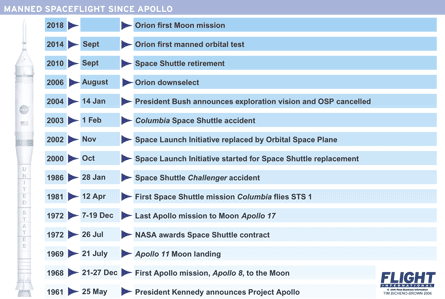
According to the leaked Constellation planning documents, the agency is planning four Orbital flight tests between 2013 and 2014. The first is set for July, August or September 2013, with the second test due in April, May or June 2014. The third and fourth tests, which are manned, are set for 2014.
The initial ISS crew transport flight is due in the first quarter of 2015. The internal document schedules eight flights to the ISS from March 2015 through to September 2016.
That same document places what it calls FT-1, Flight Test One, to the Moon in 2018, with two flight tests in 2019 and two more in 2020. It is unlikely these will all be manned or that the first few will involve lunar landings. Like Apollo, Constellation is expected to have circumlunar flight and aborted descent test runs.
But whether it is 6 April 2018 or 20 July 2021 when a human being again stands on Earth's satellite 385,000km (239,000 miles) away - if it happens at all - it will not be Apollo redux, but a new start for a permanent lunar settlement for the scientific exploration of the solar system. ■
Source: Flight International














